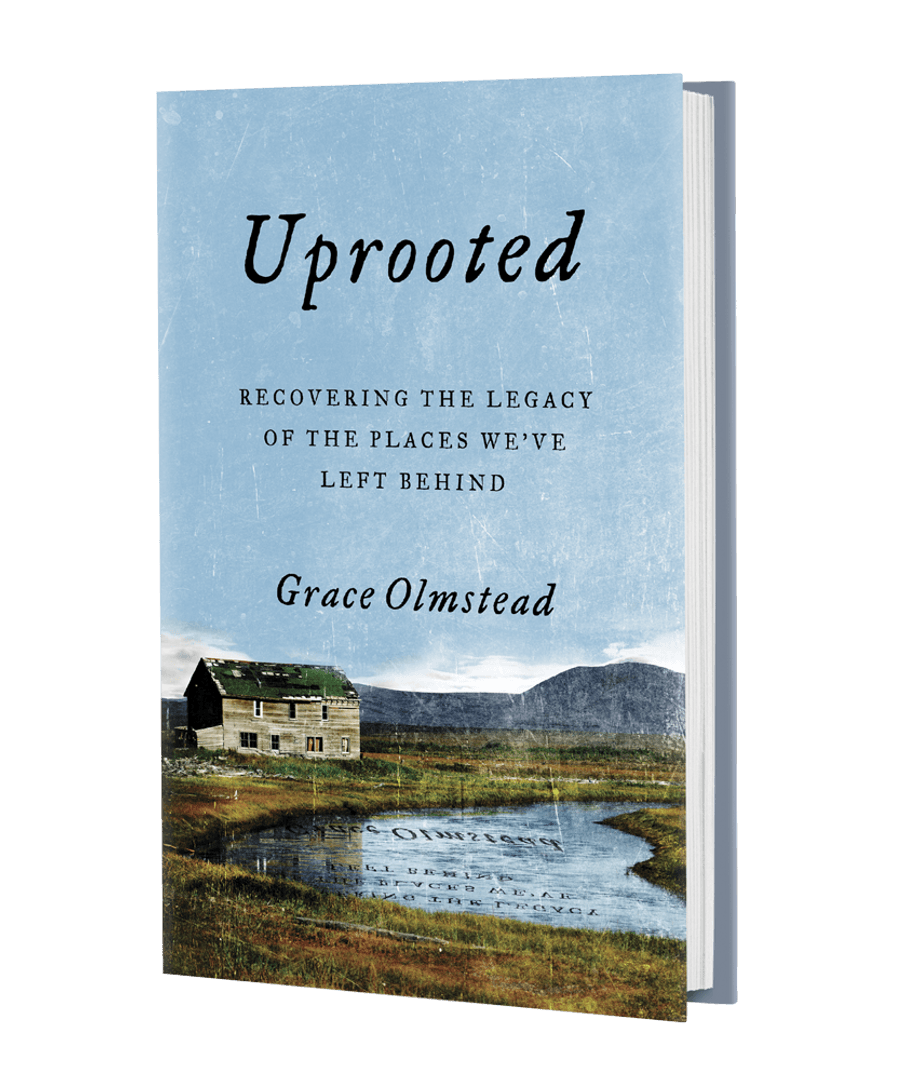[Editor’s Note: Gracy Olmstead is a journalist who focuses on farming, localism, and family. Her writing has been published in The American Conservative, The Week, The New York Times, The Washington Post, National Review, and The Wall Street Journal, among others. A native of rural Idaho, she now lives outside Washington, DC, with her husband and three children. She spoke to Charles Camosy about her book Uprooted: Recovering the Legacy of the Places We’ve Left Behind.]
Camosy: Every book has a story of how it came to be. Is it possible to briefly summarize the story of Uprooted? How did it come to be?
Olmstead: I have always been inspired by the lives of my grandparents and great-grandparents. Their love and stewardship helped foster the community I enjoyed as a kid. And my great-grandpa and grandpa, both farmers, grew the food that fed my family and me. I wanted to write something that captured the importance of their rootedness, and that considered the ways it’s grown more difficult to put down roots over time.
You and your publisher have your finger on the pulse of something important here. Like many, many others, I feel uprooted from my upbringing in rural Wisconsin now working and living in the metropolitan area of New York City. Is there some evidence of just how many folks are in this situation? And whether or not they are thriving being away from their roots?

The United States Census Bureau’s “Opportunity Atlas” allows you to see data on the percentage of adults who’ve stayed in the same commuting zone or tract where they grew up. That percentage is generally quite low throughout the heartland. That mobility isn’t always bad—often, a lack of mobility is tied to poverty, and many adults in the U.S. who do not move away have not done so because they lack the resources or support necessary to move. (But that also indicates we’ve done a horrible job, in many areas of our country, nurturing healthy economies and communities. The only way to prosper shouldn’t be to have to move away.)
As to whether people are thriving — I think many people settle in new places, and never look back. I’ve talked to plenty of others, however, who also struggle with feelings of homesickness for the places they’ve left behind.
I’ve been doing a lot of thinking and writing during the pandemic which assumes we need the rootedness of thick, extended families and communities to properly care for our beloved elderly (and especially our beloved elderly with dementia) and resist the slouch toward robots and assisted suicide. Do you agree? And, if so, can you say more about this need and what is required?
Well, I absolutely agree. And I’ve seen in my own life the gift of multigenerational living and rhythms — how much we learn and preserve, how much we’re able to serve and love each other in unique seasons of life (or in unique life circumstances) when we think about nurturing communal life outside of the nuclear family.
I just discovered this beautiful piece in Plough, about the way the Bruderhof support the author’s sister Iris, who has Down syndrome. Erna Albertz writes, “in a communal life, the gifts that Iris had to offer could be received. She was not only cared for; she was also able to reciprocate. Here, as perhaps nowhere else, she could blossom.” That is what more of us should seek to offer each other, I think: a life in which we can build habits of reciprocal care that honor the dignity and beauty of each life (no matter how frail or needy).
What is required to get there? I honestly don’t know. People moving to be closer to family seems like it could help with this, at least in some cases. (Although staying in place and building greater support networks with one’s neighbors is good, too!) But nurturing thick, supportive community tends to run counter to our work habits, car-centric lifestyles, and even our built environment. I think it’ll take a lot of little things to get us there: people being more intentional about their modes of work and worship, and how those intersect with their geography and neighborhood, for instance. I think seeking to have a home marked by hospitality could also perhaps be a part of this.
(As I’m writing this, I’m remembering that Leah Libresco Sargeant already wrote a book full of ideas on building intentional community in place! It’s called Building the Benedict Option, and everyone should read it.)
Perhaps in a related story, plenty of religious figures – many of them Catholic – are currently thinking about place, rootedness, and community as essential for vibrant religious communities capable of passing on the faith. Is this your sense as well?
I think this could be an important extension—or even implementation—of the work of fighting throwaway culture (which you’ve written about extensively). I noted on Twitter recently that the book’s idea of rootedness is meant to combat a throwaway culture which treats our communities (and the soil/ecology which undergirds them) as disposable, interchangeable, or easily abandoned. Loving a place with a rooted love requires loving it particularly and deeply; it affirms the fact that every corner of this world needs ongoing, faithful care.

I’ve been thinking a lot about Dorothy Day, Fannie Lou Hamer, Jane Addams, George Washington Carver: Their work carried them all over the world, but they also enriched a specific place and community with their work. Day lived in New York City for more than six decades, and died alongside its poor. Hamer fought for civil rights, started a farming cooperative in her home state, and served her neighbors through hospitality, financial support, and neighborliness over the course of her lifetime. Addams travelled the world, but returned to her home state of Illinois to start Hull House and fight for the rights of women and children. Carver devoted his genius to the Tuskegee Institute and to helping black farmers cultivate soil health in the South.
I think Christian love should be marked by this kind of fidelity, and I love that so many Christians have demonstrated this fidelity in a variety of ways, in such a wide variety of places.
Finally, one of the pushbacks I get from my students on this topic is that they felt as if their rootedness in the places they left behind has been a net-negative for them. And I think many of us, while also perhaps wistfully missing the communities we have left behind, can also be happy that we are not prisoners of the people we were in high school. How do you respond to these concerns?
I am very glad I’m not a prisoner of the person I was in high school! While I cannot know how the experience of rootedness was a net negative for your students, the young people I have talked to have expressed a fear that staying home, or returning home, might lock them into a place that is far too insular and reactionary.
We cannot know who we would’ve become if we’d stayed in place, how we might have resisted those tendencies or fallen prey to them. I think we can be grateful for the opportunities a wider world offers us to grow and learn, to seek out a more diverse array of experiences and viewpoints. And if someone who has had those wider experiences feels called to eventually return home, I have no doubt that their broadened viewpoint and life experience might be a blessing to some other young person in that place—helping them to see and appreciate the world in a new way.
But we should never remain in place if it’s unhealthy to do so. Many people will be called to root themselves in a community where their presence will be a net positive, both for themselves and others. And that’s something we should always applaud and support.
















